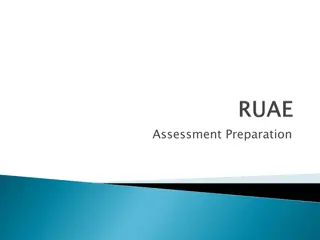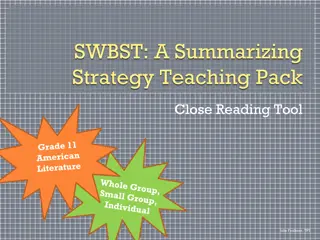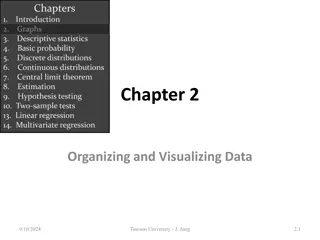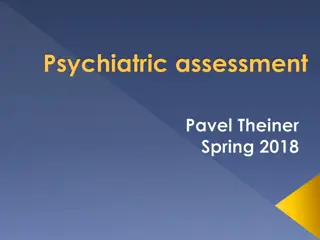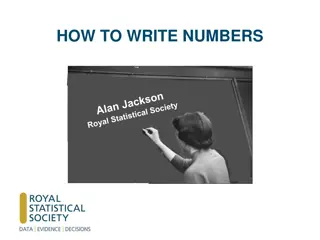Steps for Conducting Systematic Reviews
Systematic reviews are a crucial method for summarizing evidence effectively. This comprehensive guide by Irena Bond provides step-by-step instructions for beginners and junior researchers, including defining a research question, developing inclusion criteria, conducting a search, data extraction, q
4 views • 27 slides
Effective Note-Taking Strategies for Academic Success
Explore various note-taking methods discussed by Caroline Havery from UTS, such as annotating texts, creating tables for organized notes, and comparing personal note-taking styles with suggested approaches. Understand the importance of reading in depth and summarizing key points to enhance comprehen
0 views • 29 slides
Static Analysis Techniques Overview
Explore static analysis techniques such as syntactic analysis, dataflow analysis, and model checking. Understand the concept of basic blocks in static analysis and their boundaries. Dive into the opportunities provided by static analysis in summarizing program behavior without executing it.
9 views • 27 slides
Mastering Paraphrasing and Summarizing Techniques
Learn the art of paraphrasing and summarizing by practicing with exercises on rewriting passages from Rosa Parks' essay in your own words. Understand the nuances of sentence structure, word choices, and sentence types to create effective paraphrases. Discover key tips for writing a good paraphrase,
6 views • 19 slides
Mastering Quoting, Paraphrasing, and Summarizing Skills in Academic Writing
Understanding the importance of quoting, paraphrasing, and summarizing in academic writing, this tutorial explains when and how to use each method effectively. Quoting involves repeating exact words for crucial definitions or evidence, paraphrasing focuses on using your own words to convey understan
2 views • 14 slides
Effective Assessment Preparation Techniques
Enhance your assessment preparation skills with tips on answering in your own words, writing clear answers in bullet points, and summarizing key information effectively. Learn from worked examples to understand how to articulate your responses concisely and accurately.
4 views • 87 slides
Understanding Fingerprint Development Techniques
Exploring the development of latent fingerprints through physical and chemical methods, conditions affecting latent prints, and various fingerprint development techniques like visual examination, powder techniques, and chemical techniques. Techniques such as alternate light sources and powder method
2 views • 22 slides
Text Talk: Summarizing "The Eagle" by Alfred, Lord Tennyson
The task involves summarizing the poem "The Eagle" by Alfred, Lord Tennyson. The poem vividly describes an eagle perched on a crag, portraying its strength and majesty. The eagle is closely observed as it stands with the world at its feet, ready to strike like a thunderbolt. Learners are encouraged
0 views • 28 slides
Effective Techniques for Paraphrasing and Referencing
Paraphrasing involves presenting others' ideas in your own words with proper citations, while summarizing condenses information. Synthesizing sources in writing provides new insights. Understanding and internalizing the text are vital for effective paraphrasing.
2 views • 26 slides
Understanding Summarizing for Better Comprehension
Readers use summarizing by providing a brief statement of the main points of a text, focusing on key details and main ideas only. Engaging in this process helps activate the brain and aids in breaking down the text effectively to enhance understanding.
0 views • 15 slides
SWBST Summarizing Strategy Teaching Pack Overview
SWBST is a summarizing strategy designed by Julie Faulkner to help readers comprehend texts effectively. It entails breaking down texts into key components: Somebody (main character/speaker/author) Wanted (motivation), But (problem/conflict), So (solution), Then (resolution). The strategy aids in hi
0 views • 18 slides
Understanding Plagiarism: Types, Examples, and Prevention Techniques
Plagiarism is a serious academic offense that involves using someone else's work without proper acknowledgment. This publication delves into the different forms of plagiarism - intentional and accidental, such as self-plagiarism, and provides examples to help readers understand what constitutes plag
0 views • 21 slides
Applied Data Analytics Curriculum Development for Sustainable Smart Industry in Thailand
This curriculum development session focuses on basic concepts of statistics, covering population vs. sample, census, descriptive vs. inferential statistics, and methods for summarizing data using tabular, graphical, and numerical techniques. The session includes examples and visual representations t
0 views • 72 slides
Effective Use of Sources in Academic Writing
Utilizing resources effectively in academic writing involves proper use of summarizing, paraphrasing, quoting, and selecting among these techniques based on importance. It is essential to avoid patchwriting, maintain clarity, and ensure the original work's integrity while crafting your argument.
0 views • 6 slides
Analysis of Evaluation and Conclusion Questions in Textual Analysis
Evaluation and Conclusion questions play a crucial role in assessing the effectiveness of an author in achieving specific effects and summarizing key points in a passage. These types of questions are commonly found in textual analysis tasks to evaluate the success of conveying ideas and themes. Eval
0 views • 9 slides
Understanding Plagiarism and Proper Citation Techniques
Plagiarism is a serious academic offense that involves using someone else's work without proper acknowledgment. This includes copying text from the internet without citation or failing to use quotation marks when quoting an author. It is important to cite sources correctly, even when summarizing or
0 views • 38 slides
Understanding Descriptive Statistics: A Comprehensive Overview
Descriptive statistics involve organizing and presenting data to extract valuable insights. This overview covers key concepts like populations, samples, variable definitions, types of data, and methods for summarizing information. It also touches on organizing and visualizing data using graphical te
0 views • 48 slides
Mastering Paraphrasing and Summarizing in Academic Writing
Developing the skill of paraphrasing and summarizing is crucial in academic writing as it involves interpreting complex ideas and expressing them in your own words. Proper citation is essential even when paraphrasing to acknowledge the original source. Understanding cohesive devices and identifying
2 views • 27 slides
Mastering the Art of Literature Reviews: A Comprehensive Guide
Learning how to conduct a literature review is essential for any academic researcher. This process involves summarizing, evaluating, and analyzing the existing research on a topic to identify gaps, relationships, and areas for further study. By mastering the techniques outlined in this guide, resear
0 views • 18 slides
Statistical Analysis: Descriptive and Inferential Techniques Overview
Understanding statistical analysis involves both descriptive and inferential techniques. Descriptive statistics focus on summarizing data, including measures of central tendency and dispersion. In contrast, inferential statistics use sample data to make inferences about populations and test hypothes
0 views • 19 slides
Understanding Paraphrasing, Summarizing, and Direct Quoting for MLA Style
Exploring the differences among paraphrasing, summarizing, and direct quoting in MLA style. Paraphrasing involves rewriting in one's words, summarizing captures main ideas concisely, and direct quoting requires identical replication. These methods add credibility, support arguments, and serve variou
0 views • 6 slides
Enhancing Therapeutic Communication in Health Education
Establishing a therapeutic relationship is crucial in health education to achieve positive patient care goals. Effective therapeutic communication involves planned acts using various techniques to ensure a shared understanding. It focuses on clear, consistent, and direct communication, incorporating
0 views • 35 slides
Mastering Academic Writing Moves: The Art of Summarizing
In academic writing, mastering the art of summarizing is crucial for persuasive arguments. By engaging in dialogue with others and summarizing their arguments, writers can strengthen their position. It is important to strike a balance between the original author's ideas and your own, emphasizing asp
0 views • 15 slides
Effective Techniques for Summarizing and Avoiding Plagiarism
Effective strategies for summarizing include understanding the text, selecting relevant information, and rewriting main ideas in your own words. To avoid plagiarism, utilize direct quotations with proper citations, practice paraphrasing, and synthesize information from various sources. A good summar
0 views • 19 slides
Strategies for Understanding and Analyzing Texts in RUAE
Learn effective strategies for comprehending Reading, Understanding, Analysis, and Evaluation (RUAE) passages. Discover techniques such as creating mind maps, summarizing passages, and using highlighters. Practice anticipating questions, identifying key words, and matching selections with question d
1 views • 44 slides
Comprehensive Guide to Psychiatric Assessment Techniques
This detailed resource covers various aspects of psychiatric assessment including general overview, clinical interview techniques, patient meeting strategies, applying interviewing techniques, reflecting patient feelings, and summarizing patient thoughts. The content emphasizes the importance of a d
0 views • 44 slides
Techniques for Effective Passage Interpretation and Question Answering
In this guide, learn strategies for analyzing reading passages, summarizing content, and effectively answering questions. Discover the importance of pre-reading, highlighting key information, and understanding question types. Practice with tasks like creating mind maps, summarizing passages in sente
0 views • 39 slides
Exploring Motivational Interviewing and Engagement Techniques
Motivational Interviewing is a person-centered counseling style that focuses on addressing ambivalence about change. The approach involves stages such as engaging, focusing, evoking, and planning. Understanding the Transtheoretical model and the spirit of Motivational Interviewing are essential comp
0 views • 14 slides
Causes of the Great Depression: Summary and Learning Targets
Students are tasked with summarizing specific causes of the Great Depression on index cards, with topics including overproduction in agriculture and industry, unequal distribution of wealth, and high tariffs. Learning targets include summarizing relevant facts about the causes of the Great Depressio
0 views • 16 slides
Mastering the Art of Retelling: Understanding Central Messages in Stories
Explore the importance of summarizing texts and retelling stories to understand their central messages, lessons, and morals. This guide covers different grade levels and techniques for recounting stories, determining themes, and conveying key details. Gain insights on how characters respond to chall
0 views • 8 slides
Understanding and Mastering Comprehension Skills
Learn how to improve your understanding of passages through in-your-own-words exercises, summarizing key points, and tackling context questions. Enhance your vocabulary, comprehension, and reading skills by practicing these techniques before exams.
0 views • 52 slides
Techniques for Passage Comprehension
Techniques such as understanding, summarizing, and contextual analysis are essential for effective passage comprehension. In your own words, summarizing key points, and deciphering contextual questions play a vital role in grasping the content fully. By utilizing these methods, you can enhance your
0 views • 46 slides
Real-time Question Answering Using Word Embedding and Summarization Techniques
This research project aims to improve question answering over social media platforms by leveraging word embedding and summarization methods. The approach involves retrieving a large set of candidate answers from various sources, learning to rank these answers, and summarizing the top-ranked ones. Te
0 views • 22 slides
Effective Strategies for Writing Numbers and Summarizing Percentages
Discover helpful techniques for writing numbers correctly, including grammar usage and choosing between words or figures. Learn about a system for summarizing percentages, making data easier to read and recall. Explore examples where precise percentages are crucial and how different summary formats
0 views • 16 slides
Understanding Reflective Listening Techniques in Motivational Counseling Training
Reflective listening involves active listening, observing, and interpreting verbal and nonverbal cues to understand the speaker's thoughts and feelings. It includes levels of reflection such as simple rephrasing, complex paraphrasing, reflection of feeling, double-sided reflection, and summarizing t
0 views • 15 slides
Effective Exam Criteria and Study Skills Summary
Effective exam criteria and study skills involve summarizing and note-taking techniques to condense essential information. Understanding exam questions, utilizing starter sentences and connectives, structuring paragraphs, and crafting conclusions are key components. In note-taking, aim to retain nec
0 views • 9 slides
Understanding Fingerprint Development Techniques
Latent fingerprints are hidden impressions left by the friction ridges of the skin which require physical or chemical techniques for visualization. Factors affecting latent prints include surface type, touch manner, weather, humidity, perspiration, and suspect care. Techniques such as visual examina
0 views • 22 slides
Mastering Textual Evidence: Paraphrasing Techniques and Strategies
Learn the art of paraphrasing through techniques such as replacing subjects and words, rearranging sentences, and condensing information. Understand the difference between quoting, summarizing, and paraphrasing, illustrated with examples and tips on effective paraphrasing. Remember the R.A.P. approa
0 views • 8 slides
Analytical Techniques in Pharmaceutical Analysis
Analytical techniques play a crucial role in determining the identification and concentration of chemical substances in pharmaceutical analysis. Techniques range from simple gravimetric analysis to sophisticated methods using specialized instrumentation. Various techniques like gravimetric, titrimet
0 views • 17 slides
Microscopic Techniques in Cell Biology: Lessons and Labs Overview
Explore the fascinating world of optical microscopy in cellular biology, covering topics such as image formation, contrasting techniques, fluorescence microscopy, live-imaging techniques, and quantitative microscopy. Dive into the principles behind various microscopy techniques and experimental labs
0 views • 7 slides





